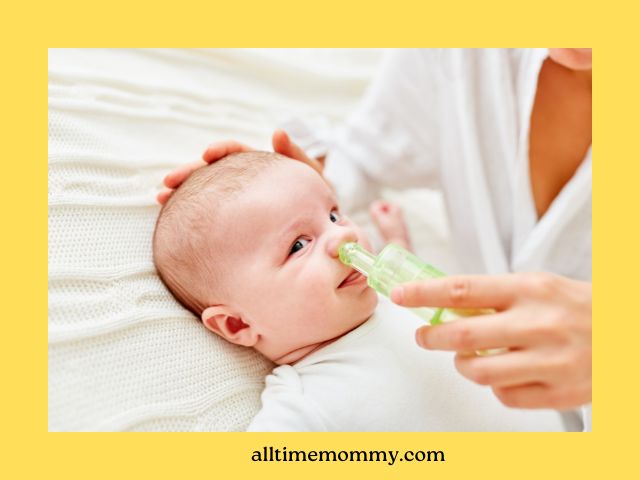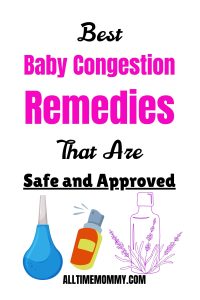As parents, nothing tugs at our heartstrings more than seeing our little ones feeling under the weather. A common cold and congestion can make even the happiest baby irritable.
They become fussy and have trouble falling and staying asleep.
Sometimes, due to congestion, they may experience low appetite or trouble feeding.
As a caregiver, you may feel drained. You’re constantly preoccupied with finding solutions. You want to try anything and everything to make your baby look alive again.
While colds are a normal part of childhood, they can be particularly distressing for both the baby and the parents.
Fortunately, numerous gentle and effective remedies are available to help alleviate your baby’s symptoms and make them feel more comfortable.
This blog will explore the best remedies for cold and congestion in babies, offering practical tips and solutions to ensure your baby breathes easier and recovers faster.
Best Remedies For Newborn Congestion
1. Saline Drops or Spray
Saline drops are simple yet effective tools for alleviating nasal congestion in newborns. They offer a safe, gentle, and natural way to decongest your newborn and promote easy breathing during a cold or when dealing with allergies.
According to research, spraying your baby’s nose with saline helps flush out mucus, crust, and other irritants. Saline loosens debris, eliminates excess mucus, and unblocks the nasal passages, thus clearing congestion.
Saline sprays are typically made with just salt and water, making them safe for use even in newborns.
They do not contain any medication or harsh chemicals, which can be too strong for a baby’s delicate system.
How to Use Saline Spray for a Newborn
- Position the Baby: Lay your baby down on its back, with its head slightly tilted back. To achieve this position, you can roll up a towel under their shoulders.
- Apply the Spray: Gently spray one or two saline drops into each nostril. Be sure to follow the instructions on the product label for the correct dosage.
- Wait a Few Moments: Allow the saline to work for a minute or two, loosening the mucus.
- Clear the Mucus: Use a bulb syringe or nasal aspirator to remove the loosened mucus from each nostril gently.
Related:
How To Relieve Constipation In Babies Quickly
2. Warm Baths and Massages
Warm baths are soothing and can help relax the baby and clear nasal congestion.
For best results, ensure the bathroom is warm and steamy by running hot water for a few minutes before bringing the baby in. The warm, moist air will also help to loosen mucus and relieve the congestion.
After the warm bath, you may want to give your baby a simple body massage to help with the cold and congestion.
Here’s how you do it.
Preparation
- Warm your baby’s room. Close the windows and possibly use room warmers to keep the temperature between 16 and 20 degrees Celsius.
- Oil/Lotion: To make the massage smooth and gentle, use a baby-safe massage oil or lotion. Warm it slightly in your hands before applying it.
- Comfortable Position: Lay your baby on a soft, flat surface, such as a changing table or bed, and ensure they are comfortable and relaxed.
How To Do Newborn Massage For Congestion
Chest Massage
- Place your hands flat on the centre of your baby’s chest.
- Gently move your hands outwards towards the shoulders, making soft sweeping motions. This can help open up the chest and ease breathing.
- Using your fingertips, make small, gentle, circular motions on the chest, especially around the ribcage. This can help loosen mucus.
Nose and Sinus Massage
- Using your thumbs, gently stroke from the bridge of the nose down to the nostrils. This can help clear nasal passages. Do not forget to make a soft pressure pass over the top of your eyebrows outwards, cheekbones, hairline, and bottom of the head. Then, up along your nose to the eye socket bone and outwards, rub two fingers down beside the front and back of your ear and down past the glands in your neck.
- With your fingertips, gently massage the area just below the baby’s eyes and along the cheekbones. Use circular motions to help relieve sinus congestion.
Back Massage
- Lay your baby on their tummy. With your hands flat, gently stroke upwards from the lower back to the shoulders. Use circular motions on either side of the spine, from the lower back to the shoulders.
Foot Massage (Reflexology)
- Gently press on the soles of your baby’s feet, focusing on the pads just below the toes. Reflexologists believe this area corresponds to the chest and lungs and can help with respiratory issues.
- Toe Massage: Gently massage each toe to help stimulate the body’s natural healing processes.
Head and Neck Massage
- Use your fingertips to gently massage the forehead in circular motions. This can help with sinus pressure.
- Also, Gently massage the neck with upward strokes to encourage lymphatic drainage, which can reduce swelling and congestion.
Related:
How To Ensure Your Baby’s Umbilical Cord Heals Faster
3. Try Suctions with a Nasal Aspirator.
A nasal aspirator is “a sucker” that pulls the mucus out of a baby’s nose. Mothers use this tool to help clear a baby’s nasal passages by removing mucus, which can help decongest the baby.
Babies, especially newborns, are not able to blow their noses.
When they have a cold or congestion, the mucus can accumulate in their nasal passages, making it strenuous for them to breathe, eat, and sleep.
Studies suggest that nasal aspirators are safe to use on newborns. They only require gentle suction, which the caregiver creates to pull mucus out of the nose.
You may consider suctioning your baby’s nose before feeding and going to bed to help them breathe easier. Ensure you use saline drops to loosen the mucus first before gently suctioning your baby.
How to Use a Nasal Aspirator Safely
- Always sterilize the aspirator before and after use.
- Ensure you use saline drops to loosen the mucus before suctioning.
- Be gentle and avoid applying too much pressure, as the baby’s nasal tissues are delicate.
- Do not overuse the aspirator, as it can irritate the nasal lining.
Using a nasal aspirator correctly can significantly relieve a baby’s nasal congestion and help them feel more comfortable.
4. Cool Mist Humidifier in the Room
A cool mist humidifier is essential for adding moisture to the air, especially in your baby’s room. By maintaining a more humid environment, a cool mist humidifier can effectively help alleviate congestion in babies, leading to more comfortable breathing and better overall well-being. When the air is dry, mucus thickens and becomes more challenging to expel, leading to congestion.
Tips for Using a Humidifier:
- Ensure the humidifier is clean to prevent mould and bacteria growth, which can harm the baby.
- Distilled or purified water is advisable to avoid mineral buildup in the humidifier.
- Place the humidifier on a flat, elevated surface away from the baby’s reach to prevent accidents and ensure the mist is dispersed throughout the room.
5. Breastfeed More
Breast milk is a natural source of hydration. When your baby is congested, staying well-hydrated is crucial because it helps to thin the mucus in their nasal passages, making it easier to expel.
Thinner mucus is less likely to block the airways, allowing your baby to breathe more comfortably.
Breast milk contains antibodies. It also has immune-boosting factors that can help your baby fight off the infection causing congestion.
These immune components help reduce the severity and duration of the illness, indirectly helping to clear the congestion.
additionally,
The act of sucking during breastfeeding can help relieve congestion. The suction helps clear the baby’s nasal passages by encouraging them to swallow more frequently, which can move mucus out of the nasal passages and down the throat.
Consider putting a few drops of your milk in their nostrils to loosen the mucus. Breastmilk is a home remedy for various baby illnesses, including blocked noses.
Best Remedies for Cold & Congestion for Kids Above Two Years
Are you looking for effective and safe home remedies to relieve congestion in kids over two years old? Explore these natural treatments and simple techniques to help ease your child’s stuffy nose. These remedies will decongest your child’s chest, ease breathing, and ensure comfort and better sleep.
Ready for these?
Here we go.
1. Steam Baths and Steam Inhalation to Clear the Mucus.
Inhaling steam helps to loosen thick mucus, which can be cleared more easily by nose blowing, coughing or sneezing. This is particularly helpful when your child has a cold or respiratory infection, as it reduces mucus buildup in the nose and chest.
Steam Inhalation process
Option one
Sit with the child in a steamy bathroom to help loosen mucus and relieve congestion. Just be sure always to supervise your kid in a humid or steamy environment.
Option two.
These are the items you’ll need
- A bowl or a small plastic basin
- Hot water
- A towel
- Optional: Eucalyptus oil or other child-safe essential oils (ensure they are safe for your child’s age)
Steps:
- Fill a bowl or a basin with hot water. Make sure the water is steaming but not too hot to cause burns.
- Have your child sit comfortably near the bowl. For maximum safety, consider putting her on your lap.
- Create a Tent. Place a towel over your child’s head and the bowl or basin to trap the steam. Ensure there’s still some airflow and the steam is manageable for them.
- Please encourage your child to breathe in the steam gently through their nose and mouth for 5–10 minutes. You can make this process more engaging by singing or telling a story.
- Add essential oil (Optional). If your child is old enough and not sensitive to scents, add a drop or two of child-safe essential oils like eucalyptus or lavender to the water. This can enhance the decongestant effect and create a soothing aroma.
- Always supervise your child during steam inhalation to ensure they are safe and comfortable.
Tips:
- Steam inhalation is generally recommended for children over 2 years old.
- Ensure the water is hot enough to provide steam for at least five minutes.
- Keep the session short, around 5–10 minutes, and limit it to 2–3 times a day.
2. Chest Massage with Eucalyptus and Castor oil
Chest massages with eucalyptus oil are one of my favourite chest decongestion remedies for my three-year-old kid.
Why?
Eucalyptus oil contains cineole (eucalyptol), which has natural decongestant, anti-inflammatory, and antimicrobial properties.
When applied to the chest, the oil’s vapour is inhaled, helping to open up the nasal passages, reduce mucus, and improve breathing.
The aroma of eucalyptus oil can stimulate the release and clearance of mucus from the respiratory tract. This can help relieve congestion in the chest and nose, making breathing more manageable for your child.
This is How You Do Chest Massage for Decongestion.
- Get eucalyptus and castor oil, one to three drops each, depending on your child’s age.
- Warm it slightly by rubbing it between your hands. This makes it more comfortable for your child.
- Lay your child on their back, either in their bed or on a comfortable surface.
- Using your fingertips, gently massage the chest area in small, circular motions. Start from the centre of the chest and move outward. Use light to moderate pressure, depending on what feels comfortable for your child.
- Also, please have your child lie on their stomach so you can gently massage their upper back. Use the same circular motions, working from the centre outward.
- You can extend the massage to the neck and shoulders, as this can help ease tension and promote relaxation.
Continue the massage for about 2–5 minutes or until your child feels relaxed and comfortable.
Tips:
- Choose the Right Product: Use a balm or oil specifically designed for children. If using essential oils, ensure they are safe for your child’s age and dilute them properly in carrier oil.
- Check for Allergies: Always test a small amount of the oil or balm on a patch of your child’s skin to check for any allergic reactions before the full massage.
- Be Gentle: Use gentle, soothing motions. The goal is to relax your child and help ease their breathing, not to apply too much pressure.
3. Onion in Socks
Placing onions in socks to ease congestion is a popular folk remedy but lacks scientific evidence. However, I have tested it with my kids, and it works.
Why?
Onions contain a compound called Quercetin. Quercetin is an antibacterial, antihistamine, and anti-inflammatory good for colds and congestion.
In fact, some studies show that onion extract concentrate may help with certain respiratory diseases.
The theory behind placing onion slices in socks is that the sulfur and quercetin compounds in onions, which have known antibacterial and anti-inflammatory properties, are absorbed through the skin of the feet, helping to draw out toxins and reduce congestion.
The feet have pressure points connected to various organs and systems in the body (a concept known as reflexology). Onions are thought to have healing properties directed towards the respiratory system when placed on the feet.
How to Use Onion for Baby Congestion
- Cut a fresh onion into thin round slices (red or white onion are the best for this course)
- First, massage the onion on the soles of your kid’s feet.
- Put the slices directly on the soles of your child’s feet.
- Please have your child wear socks over the onion slices and leave them on overnight.
4. Saline sprays
Saline spray is an effective home remedy for alleviating your child’s congestion.
When a child is congested, mucus can become thick and sticky, making breathing difficult. The saline solution in the spray helps to break down and thin out the mucus, allowing it to flow more freely and be cleared from the nasal passages.
Furthermore, they also help reduce bad smells from the nose.
How to Use Saline Sprays for Kids
- Apply Properly
Have the child lie down or sit with their head slightly tilted back. Insert the nozzle of the spry bottle into one nostril and squeeze to release the spray. Repeat for the other nostril.
- Suction for infants
After applying the saline spray, you may help your child blow their nose or gently use a nasal aspirator to suction out the loosened mucus. Doing so can help clear the nasal passages more effectively.
- Use Before Feeding or Sleeping
Applying saline spray before feeding or sleeping to help decongest the nasal passages.
- Regular Use
Saline sprays can be used several times daily, especially before naps, bedtime, or feeding times, to help clear the nasal passages.
5. Saltwater Gaggling
According to this study, Gargling with salt water can help reduce the severity of cold and nasal congestion.
Helping your child gaggle with saltwater will loosen mucus, open their airways, and help them breathe properly.
How to help your child do saltwater gaggle
- Get a glass of warm water
- Add 1 teaspoon of Epsom salt.
- Make your child swish it around their mouth and throat.
- Spit it out.
Preventive Measures For Baby Congestion
There are several ways to help reduce the chances and severity of cold infections in your children. These include:
- Keep your child warm, especially the feet and head
Dress your baby in soft, breathable layers that can removed easily. You may also Use a Humidifier. A warm-mist humidifier can help keep the room warm while adding moisture to the air, which can help reduce congestion.
- Keep your room surfaces clean and well-ventilated
Regular cleaning helps remove dust, dirt, pet dander and other allergens from surfaces where germs, bacteria, and viruses can thrive. Disinfecting high-touch areas (like doorknobs, light switches, and toys) reduces the likelihood of transferring pathogens from surfaces to people.
Proper ventilation circulates fresh air into the room and expels stale air, which may contain pollutants, bacteria, and viruses. This constant fresh air flow reduces the concentration of harmful airborne particles, lowering the risk of respiratory infections.
Additionally, Good ventilation helps control humidity levels, preventing the growth of mold and mildew. Please note that mold thrives in damp environments and may cause respiratory problems.
- Fortify your children’s immunity through good nutrition and supplements.
Infact, a study suggests cod liver oil supplements may decrease your trips to the doctor, especially those related to upper respiratory illnesses, by upto 36 to 58 percent.
When to Worry about Baby Congestion
You need to visit a professional healthcare provider when your baby
- Start to breathe faster
- Experiences diaphragmatic breathing
- has a persistent high fever
- stops feeding
DISCLAIMER The information contained in this post is for general information purposes only. I’m not a health practitioner and as such, this information should not be used as a substitute for consultation with your professional service provider.




